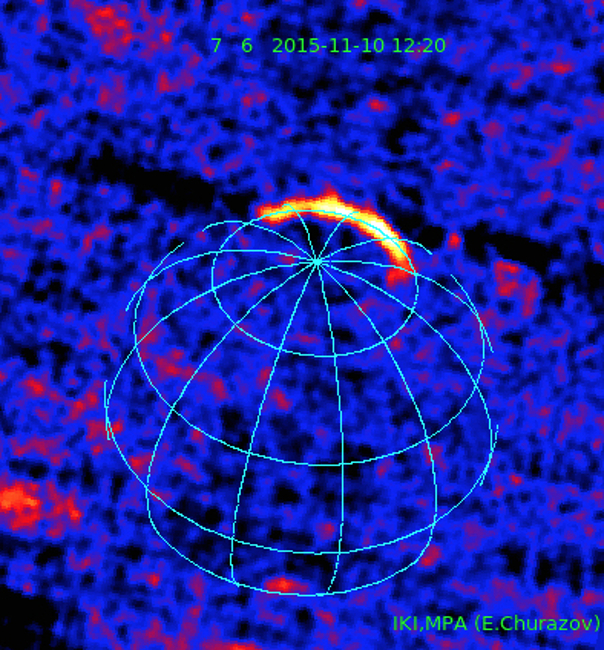
 Credit: ESA/Integral/ E. Churazov (IKI/MPA)/ M. Türler (ISDC/Univ. of Geneva)
Credit: ESA/Integral/ E. Churazov (IKI/MPA)/ M. Türler (ISDC/Univ. of Geneva)
Shadow of an Aurora
High-energy X-ray and Gamma-ray radiation is difficult to image. Lenses and mirrors that create images in visible light, or even grazing-incidence mirrors like those on the Chandra X-ray Observatory which are used to produce images at low-energy X-ray energies, don't work very well on very high-energy radiation. Trying to make an image at high energies requires advanced techniques. For example, the NuSTAR observatory produces images at very high X-ray energy by using specially-coated mirrors and special detectors. A simpler technology used to produce images at high X-ray energies is the "coded mask". Coded masks are grids of opaque material arranged in a particular pattern, placed in front of an imaging detector. A source of high energy radiation shining on the coded mask produces a patterned shadow on the detector. By careful analysis of the shadow pattern, the image of the source can be reconstructed. The Imager on Board the INTEGRAL Satellite (IBIS) instrument uses coded masks to create images of celestial sources of high-energy radiation. A beautiful example is shown above - an image of the high energy radiation produced by earth's aurora, seen by the IBIS and reconstructed from its shadow pattern. IBIS shows the circular arc of the aurora's high energy emission, which is produced by charged particles from the sun that hit the earth's magnetic field and rapidly decelerate. The earth itself emits no high-energy emission, so it does not show up in the IBIS image; to guide the eye the outline of the earth is drawn in the image above.
Published: February 1, 2016
<
HEA Dictionary ● Archive
● Search HEAPOW
● Other Languages
● HEAPOW on Facebook
● Download all Images
● Education ● HEAD
>

Each week the HEASARC
brings you new, exciting and beautiful images from X-ray and Gamma ray
astronomy. Check back each week and be sure to check out the HEAPOW archive!
Page Author: Dr. Michael F. Corcoran
Last modified Tuesday, 27-Feb-2024 10:08:16 EST


